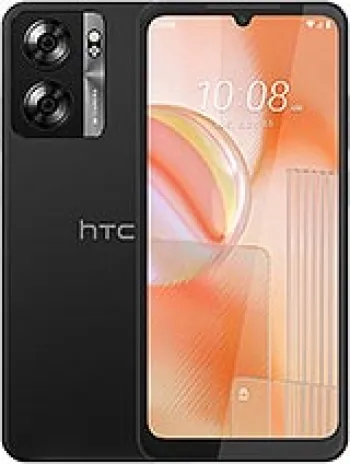
Overview of HTC P3350
The HTC P3350, announced in February 2007, is a smartphone that represents a bridge between traditional keypad phones and the emerging world of touch-enabled devices during its time. Designed with productivity in mind, the P3350 integrates multimedia capabilities with typical PDA functionalities. Built for professionals and tech-savvy users, this device promises a comprehensive mobile experience leveraging Microsoft's Windows Mobile 5.0 PocketPC OS.
Design and Build
The HTC P3350 boasts a compact design with dimensions of 108 x 58 x 16.8 mm, fitting comfortably in hand or pocket. Weighing in at 130 grams, it strikes a balance between being lightweight and robust. The choice of silver gives it an elegant and professional look. The device uses a Mini-SIM and comes with a removable Li-Ion 1200 mAh battery—an average capacity for its time, delivering an estimated stand-by time of up to 200 hours and talk time of approximately 4 hours.
Display
The smartphone features a 2.8-inch TFT resistive touchscreen that supports 65,000 colors. With a resolution of 240 x 320 pixels and a pixel density of approximately 143 ppi, the display offers standard clarity for everyday tasks such as reading texts, browsing the web, and utilizing apps. The screen's aspect ratio of 4:3 is common in devices from this era, providing a balanced view for both media and document viewing.
Hardware and Performance
Under the hood, the HTC P3350 is powered by the TI OMAP 850 chipset featuring a 200 MHz ARM926EJ-S processor. While this processor might seem modest by today's standards, it was sufficient for handling the responsibilities of a smartphone built for email, calendar management, and basic multimedia playback in 2007. The device supports 64MB of RAM and 128MB ROM, with the option to expand storage via a dedicated microSD slot—a feature appreciated by users needing additional space for music, documents, or applications.
Operating System
Running on Microsoft Windows Mobile 5.0 PocketPC, the HTC P3350 is equipped to execute a variety of productivity applications available in the Windows Mobile ecosystem of its time. The system provides essential tools such as Pocket Office, enabling users to view Word, Excel, and PowerPoint files on the go. User experience is further enriched by features like WAP 2.0/xHTML and HTML (PocketIE) browsing capabilities, customizability of downloadable applications, and efficient multitasking suitable for professional needs.
Camera
In terms of photography, the HTC P3350 offers a 2 MP rear camera capable of capturing essential life moments and business images. The camera functions are basic, aligned with the standards of its time, and while there is no front-facing camera, the primary camera can record videos, making it versatile for simple video needs.
Connectivity
The device supports GSM technology and covers a range of 2G bands including GSM 850, 900, 1800, and 1900. This makes it suited for global travel within regions where GSM networks are available. Connectivity features include GPRS Class 10 and EDGE Class 10 for data transfer, alongside Wi-Fi 802.11b/g for internet connectivity through wireless networks. Bluetooth 2.0 with A2DP supports wireless streaming of audio, enhancing the multimedia experience. Additionally, an FM radio is included for entertainment purposes, complemented with miniUSB for charging and data transfer.
Audio and Multimedia
Multimedia capabilities are highlighted by support for various audio formats and the presence of a loudspeaker. While it lacks a 3.5mm audio jack, the Bluetooth A2DP profile allows users to connect wireless headphones for music and calls. Audio alerts include vibration and downloadable polyphonic or MP3 ringtones, allowing for personalization of the device’s sound experience.
Battery Life
The HTC P3350 is equipped with a removable Li-Ion 1200 mAh battery, reflecting the typical energy demands of early smartphones. The battery offers a satisfactory performance for its era, with an approximate 4-hour talk time and up to 200 hours on standby, aligning with user expectations for daily usage away from frequent recharges.
Market and Pricing
When launched, the HTC P3350 was priced around 210 EUR, positioning it within the affordability bracket of PDAs and entry-level smartphones. Its release symbolized a shift towards mobile computing, paving the way for future innovation. Discontinued after its commercial release, the HTC P3350 today serves as a nostalgic piece of technology history, remembered for its role in the evolution towards modern-day smartphones.
Key Features of HTC P3350
- GSM Technology with global band support (GSM 850/900/1800/1900)
- Compact design with dimensions 108 x 58 x 16.8 mm
- Lightweight at 130 g
- TFT resistive touchscreen supporting 65K colors
- 2.8-inch display with a resolution of 240 x 320 pixels
- Runs on Microsoft Windows Mobile 5.0 PocketPC
- Powered by TI OMAP 850 chipset and a 200 MHz CPU
- Expandable memory via microSD card slot
- 2 MP main camera with video recording capabilities
- Wi-Fi 802.11b/g support for internet connectivity
- Bluetooth 2.0 with A2DP for wireless data transfer
- FM radio for entertainment on the go
- Removable Li-Ion 1200 mAh battery providing decent standby and talk time
HTC P3350: Key Disadvantages
- The device operates on outdated GSM technology, limiting network compatibility with modern standards.
- Released in 2007 and now discontinued, meaning there is no longer official support or updates.
- Utilizes a TFT resistive touchscreen with only 65K colors and a low screen-to-body ratio, affecting display quality and touch responsiveness.
- The resolution and pixel density (240 x 320 pixels, ~143 ppi) are quite low, leading to less sharp images.
- Equipped with an outdated Microsoft Windows Mobile 5.0 OS and a 200 MHz processor, providing limited performance compared to current standards.
- Limited internal memory with only 64MB RAM and 128MB ROM, restricting multitasking and storage capacity.
- Lack of a front (selfie) camera.
- Absence of a 3.5mm headphone jack, requiring an adapter or alternate audio solutions.
- No GPS functionality, limiting its capability for navigation purposes.
- Battery life is relatively short, with a talk time of up to 4 hours only.

View Also
More Phones
All Rights Reserved +14266 Phones © Mobilawy 2025

























